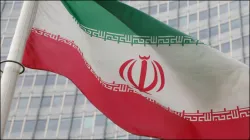Iran increases enriched uranium stockpile to near weapons-grade limits amid stalled nuclear talks: UN report
The report by the International Atomic Energy Agency (IAEA) means that Iran can produce as many as three nuclear weapons if its uranium stockpile is enriched further. Iran's overall stockpile of enriched uranium has vastly exceeded the limits of the suspended 2015 nuclear deal.

Vienna: Iran has further increased its stockpile of enriched uranium to near weapons-grade limits, which means that it can produce nuclear weapons despite sanctions by Western countries, according to a confidential report by the UN's nuclear watchdog on Monday. This comes as talks between Iran and the International Atomic Energy Agency (IAEA) over restarting a suspended 2015 deal are stalled following the death of Iranian President Ebrahim Raisi.
Under the deal, Iran seeks relief from economic sanctions imposed on its controversial nuclear programme in exchange for curbing its weapons stockpile. The nuclear programme is controlled by Iran's Supreme Leader Ayatollah Ali Khamenei and will likely remain unchanged even after the death of Raisi and foreign minister Hossein Amir-Abdollahian in a tragic helicopter crash.
The IAEA report said that as of May 11, Iran has 142.1 kg (313.2 pounds) of enriched uranium up to 60 per cent, an increase of 20.6 kg (45.4 pounds) since the last report by the UN watchdog in February. Uranium enriched at 60 per cent purity is just a short, technical step away from weapons-grade levels of 90 per cent. The IAEA previously predicted that Iran has enough material enriched to that level, if refined further, for three nuclear bombs.
According to an IAEA estimate, around 42 kg of uranium enriched to 60 per cent is the theoretical amount required to create one atomic weapon, if the material is further enriched to 90 per cent. Iran’s overall stockpile of enriched uranium stands at 6,201.3 kg (1,3671.5 pounds), which represents an increase of 675.8 kg since IAEA's previous report and vastly exceeds the limit stipulated in the 2015 deal.
Difficulties in nuclear talks with Iran
The report comes against the backdrop of heightened tensions in the wider Middle East over the ongoing Israel-Hamas war, as Israel and Iran have carried out direct strikes on each other’s territory for the first time last month, raising tensions across the world. The UN agency has so far implemented a small fraction of the steps IAEA chief Rafael Grossi thought it committed to in a "Joint Statement" on cooperation last year.
Grossi, who travelled to Iran this month for talks with Iranian officials aimed at improving cooperation and IAEA monitoring, previously warned that Tehran has enough uranium enriched to near-weapons-grade levels to make “several” nuclear bombs if it chose to do so. Iran abandoned all limits of the 2015 nuclear deal since former US President Donald Trump unilaterally withdrew from the agreement in 2018.
Under the original nuclear deal, struck in 2015, Iran was allowed to enrich uranium only up to 3.67 per cent purity, maintain a stockpile of about 300 kilograms and use only very basic IR-1 centrifuges — machines that spin uranium gas at high speed for enrichment purposes. The 2015 deal saw Tehran agree to limit enrichment of uranium to levels necessary for generating nuclear power in exchange for the lifting of economic sanctions.
"The Director General reiterates to the new government of Iran his call for, and disposition to continue with, the high-level dialogue and ensuing technical exchanges commenced ... on 6-7 May 2024," the IAEA report added, 18 months after the agency's 35-nation Board of Governors passed a resolution against Iran, ordering it to cooperate urgently with an IAEA investigation into uranium particles found at three undeclared sites.
Iran's deal with IAEA prior to Raisi's death
The report on Monday also said that Iran has not reconsidered its September 2023 decision to bar IAEA inspectors from further monitoring its nuclear programme. As per the report, Grossi “deeply regrets” Iran’s decision to bar inspectors — and a reversal of that decision “remains essential to fully allow the agency to conduct its verification activities in Iran effectively.”
Before the May 19 helicopter crash, Iran had agreed to hold technical negotiations with the IAEA on May 20, following a visit by Grossi earlier in the month. But those meetings fell apart due to the crash. Iran then sent a letter on May 21, saying its nuclear team wants to continue discussions in Tehran “on an appropriate date that will be mutually agreed upon,” the report said.
The report also said there was no progress so far in reinstalling more monitoring equipment, including cameras, removed in June 2022. Since then, the only recorded data is that of IAEA cameras installed at a centrifuge workshop in the city of Isfahan in May 2023 — although Iran has not provided the IAEA with access to this data.
(with inputs from agencies)
ALSO READ | Iran's acting President Mokhber's first address in new parliament after Raisi helicopter crash I VIDEO
